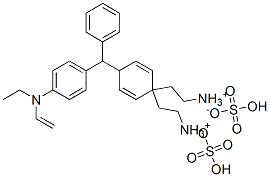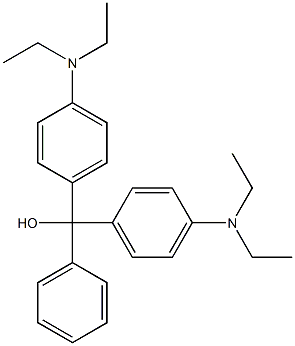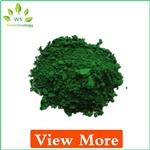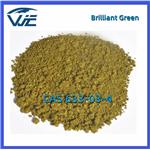Description
C.I. Basic Green 1 is a metallic green, odorlesscrystal or powder. Molecular weight =482.69; Meltingpoint =210℃. Soluble in water.
Chemical Properties
metallic green crystals
Chemical Properties
C.I. Basic Green 1 is a metallic green, odorless crystal or powder
Uses
Brilliant Green a stain used in bacteriological media.
Uses
Dyeing silk, wool, leather, jute and cotton yellowish-green; manufacture of green ink; biological stain; indicator.
Definition
ChEBI: An organic hydrogensulfate salt having 4-{[4-(diethylamino)phenyl](phenyl)methylidene}-N,N-diethylcyclohexa-2,5-dien-1-iminium as the counterion.
Preparation
in the presence of sulfuric acid hydrochloric acid or, Benzaldehyde?and N,N-diethylbenzenamine condensation, and then will product oxidation, and translated into sulfate. The first generation of resin mixture will suddenly for curing crystalline good crystals.
General Description
Brilliant green is a triphenylmethane dye, found to be toxic to humans and animals. It is widely used in dying wool, leather, silk, jute, and cotton. It is also used in the manufacturing of green ink, as a staining constituent of bacteriological media.
Flammability and Explosibility
Non flammable
Biochem/physiol Actions
Brilliant Green is a dye and an antiseptic agent.
Safety Profile
Poison by ingestion,
intraperitoneal, and intravenous routes. A
rmld human skin irritant. Mutation data
reported. See also ALDEHYDES and
SULFATES. When heated to
decomposition it emits very toxic fumes of
NOx, NH3, and SOx.
Potential Exposure
C.I. Basic Green 1 is used in dyeing silk, wool, leather, jute, and cotton yellowish-green; manufacturing green ink; as staining constituent of bacteriological media; indicator, an intestinal anthelmintic; a C.I. Basic Green 1 861 wound antiseptic; treatment of mycotic infections; agricultural fungicide (Not registered as a pesticide in the United States).
First aid
If this chemical gets into the eyes, remove anycontact lenses at once and irrigate immediately for atleast 15 min, occasionally lifting upper and lower lids.Seek medical attention immediately. If this chemical contacts the skin, remove contaminated clothing and washimmediately with soap and water. Seek medical attentionimmediately. If this chemical has been inhaled, removefrom exposure, begin rescue breathing (using universalprecautions, including resuscitation mask) if breathing hasstopped and CPR if heart action has stopped. Transferpromptly to a medical facility. When this chemical hasbeen swallowed, get medical attention. Give large quantities of water and induce vomiting. Do not make anunconscious person vomit.
storage
Color Code—Blue: Health Hazard/Poison: Storein a secure poison location
Shipping
UN3143 Dyes, solid, toxic, n.o.s. or Dye intermediates, solid, toxic, n.o.s., Hazard Class: 6.1; Labels: 6.1-Poisonous materials, Technical Name Required. UN2811 Toxic solids, organic, n.o.s., Hazard Class: 6.1; Labels: 6.1-Poisonous materials, Technical Name Required.
Purification Methods
Purify the dye by precipitating the perchlorate from aqueous solution (0.3%) after filtering, heating to 75o and adjusting to pH 1-2. Recrystallise it from EtOH/water (1:4) [Kerr & Gregory Analyst (London) 94 1036 1969]. [Beilstein 13 IV 2281.]
Properties and Applications
bright green. Green flash golden sand shape. Slightly soluble in cold water, in 98 ℃ of hot water dissolves only 8 g/L, soluble in ethanol to blue. The strong sulfuric acid for yellow green, diluted into blue; For orange in nitric acid. The dye solution for blue purple, add sodium hydroxide have dark purple precipitation; Join the hydrochloric acid become green light yellow. Used for silk, wool, acrylic, tannin mordant dyeing cotton cloth dyeing. Also used in leather, hemp, paper, wood, bamboo or color, also used in the manufacture of paint, medicine used for disinfectant.
|
Standard
|
Light Fastness
|
Persperation Fastness
|
Ironing Fastness
|
Soaping
|
|
Fading
|
Stain
|
Fading
|
Stain
|
Fading
|
Stain
|
|
ISO
|
4
|
4
|
4-5
|
|
|
4
|
4-5
|
|
AATCC
|
2-3
|
|
|
|
|
|
|
Incompatibilities
Oxidizing agents, reducing agents; anionics, and aqueous solutions of bentonite. Keep away from moisture





